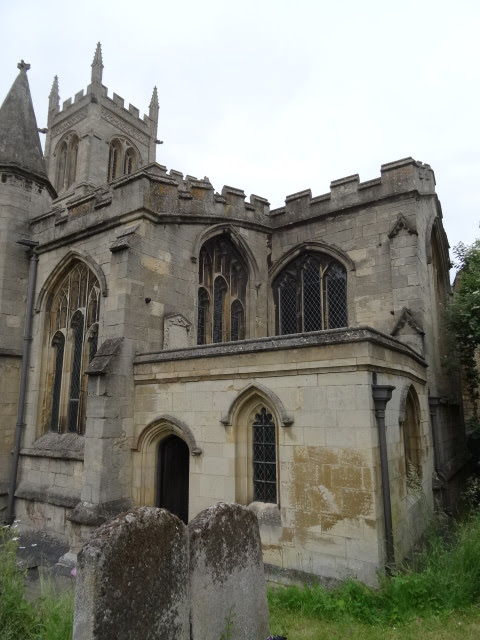I completed a new collage on Saturday; a Foliate Head, breaking new ground for me with use of coloured ink in the background.
Monday, 25 June 2018
Monday, 18 June 2018
St Mary, Essendine
Not long back from a visit to St Mary, Essendine, just a short hop over the border in Rutland. Another church I have been past innumerable times and not entered. A small, charming country church. Simple plan - just nave and smaller chancel, both aisle-less. No tower, but a bellcote such as can be found all over Rutland. Nothing really to write home about architecturally except the south door which is very beautiful. Norman, and not that grand having only two colonettes framing the door. However what sets it apart is the amount of carving which is unusually lavish: each of the colonettes is spirally fluted; the tympanum is carved with angels and Christ, as Pantocrator, blessing visitors; in addition the door jambs are decorated with carved scenes both outside and inside. All told quite a rare thing, though there is a something similar at Castor, not so many miles away to the south. A little bit of Byzantium deep in the East Midlands countryside.
The church itself sits inside a group of massive ditches - the remains of a castle. It is said that the church formed the castle chapel. Inside is cool and white, there are few memorials or any other features of note, but it is none the worse for that, or for what must have been a thoroughgoing restoration in the middle of the 19th century by a unknown architect.
Labels:
architecture,
churches,
England,
Essendine,
Limestone Belt,
Rutland
Wednesday, 13 June 2018
St John the Baptist, Stamford
When a child I was told Stamford was remarkable, not only because it was beautiful, a bit posh, but because it straddled 3/4 counties (depending on what county the Soke of Peterborough was then annexed to) and had six churches. Walking round Stamford its quite easy to be taken up with the town's Georgian aspect, however those six churches take us right back to the Middle Ages in a way that is often difficult in towns of equal antiquity with the exception perhaps of York and Norwich. Medieval urbanism, to me at least has a sort of intensity of vision, an element of the fantastical that is deeply satisfying.
St John's church is quite small, but has a quiet, workman-like grandeur - it was all rebuilt sometime in the Late Middle Ages and is hence all one consistent style - Perp. It is tucked away at one corner of Red Lion Square, diagonally opposite the grander All Saints church, and mostly hidden behind the buildings in the High St. The design of the tower is very good, and I like the solidity of the west front with its layering and the way that the west door is hewn from the mass of masonry reminding me of the west front of St Martin's across the Welland. In fact by comparing the images on my blogpost on St Martin's I will make so bold as to suggest both churches are by the same master mason. There is a pretty little south porch that looks like an addition to the original design, that gives access to a small, secluded graveyard. The plan is very simple - a basilica with a chancel projecting one bay east. The tower is tucked into the NW corner, and somehow that saves the interior of St John's from being too rational an experience, the tower base serving as a sort of halfway, or indeed liminal space, between the outside and the sacred interior. The piers, I think, follow an East Anglian pattern - they certainly put me in mind of the simpler piers at South Creake in Norfolk. The nave roof is populated with angels, but as to Medieval furnishings there is some glass left in three of the windows (N aisle), and there are wooden parclose screens remaining in both aisles, but everything else has been lost. There are a lot of wall memorials, mostly Georgian and early Victorian and classical. The church was restored in 1856 by Edward Browning, who we have encountered many times on this blog.
Another Announcement!
Yes, another announcement.
I'm really pleased to say that you can now buy from a selection of my artwork on-line at Gallery Stamford www.gallerystamford.co.uk
Wednesday, 6 June 2018
Own work: the Methodist Chapel, Bourne
I finished this an hour ago. It's taken two weeks and three attempts to produce something I'm vaguely satisfied with; mainly I think caused by the evenness of the building and texture. I more readily respond to the picturesque, the textured, bricolage. The usual mixed media, and, like my Baptist Chapel of a month ago, a rather Piper-esque painting. The chapel itself is the work of the nineteenth century Bourne architect Thomas Pilkington, who was responsible for the Town Hall in Market Deeping which this blog visited in Jan 2017. Here A cold, grey looking day it was too, when the sky and stone of the buildings around me were almost the same colour.
Labels:
architecture,
Bourne,
chapels,
England,
Lincolnshire,
Neo-classicism,
Own work,
Thomas Pilkington,
Topography
Subscribe to:
Comments (Atom)






























